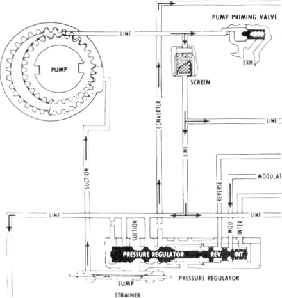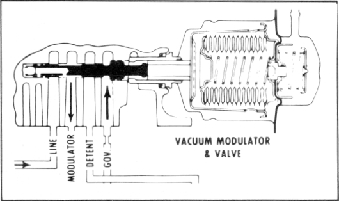


Fig. 27M-Pump Pressure
reverse to get the maximum apply load. Reverse oil is directed
to the pressure regulator valve (fig. 26M) to increase the main
line pressure. Reverse oil is applied directly to the large areas
of these two clutches and to the small areas via the shift valves.
Fig. 28M-Governor
Fig. 29M-Vacuum Modulator
Oil Pump Pressure Regulation
Pump Oil Pressure is obtained when the Engine and Con
verter drive the Pump Gears, which compress oil sucked
through the oil strainer. Air in the circuit is expelled at the
Priming Valve until oil pressure reaches 5 P.S.I.
The Oil Pressure is regulated by the Pressure Regulator
Valve and Spring (fig. 27M). The Boost valves aid the spring
to increase the pressure when Modulator, Reverse, and/or
Intermediate oil is fed to the Reverse and Intermediate Boost
Valve lands. High boost results in High Line Pressure.
Oil from the Pressure Regulator Valve feeds the Converter.
This oil is also directed to the Modulator, 1-2 Accumulator,
Detent Regulator, and Manual Valve. Manual valve position
directs oil to the Governor, Shift Valves, 2-3 Accumulator, and
Intermediate Servo, to apply the Clutches and Band.
Governor Regulation of Pressure (Fig. 28M)
The Car Speed signal to the transmission is governor
pressure (regulated from drive oil pressure) which moves the
shift valves to obtain the 1-2 and 2-3 shifts.
High Car Speed results in high governor pressure.
Vacuum Modulator Regulation of Pressure (Fig. 39)
Engine vacuum indicates carburetor (throttle) opening and
engine torque required. This signal (vacuum) moves the
vacuum modulator diaphragm assembly which actuates the
modulator valve to regulate lin pressure into modulator
pressure (fig. 29M). High vacuum (Low torque signal) results
in low modulator pressure; low vacuum (high torque signal)
results in high modulator pressure.
